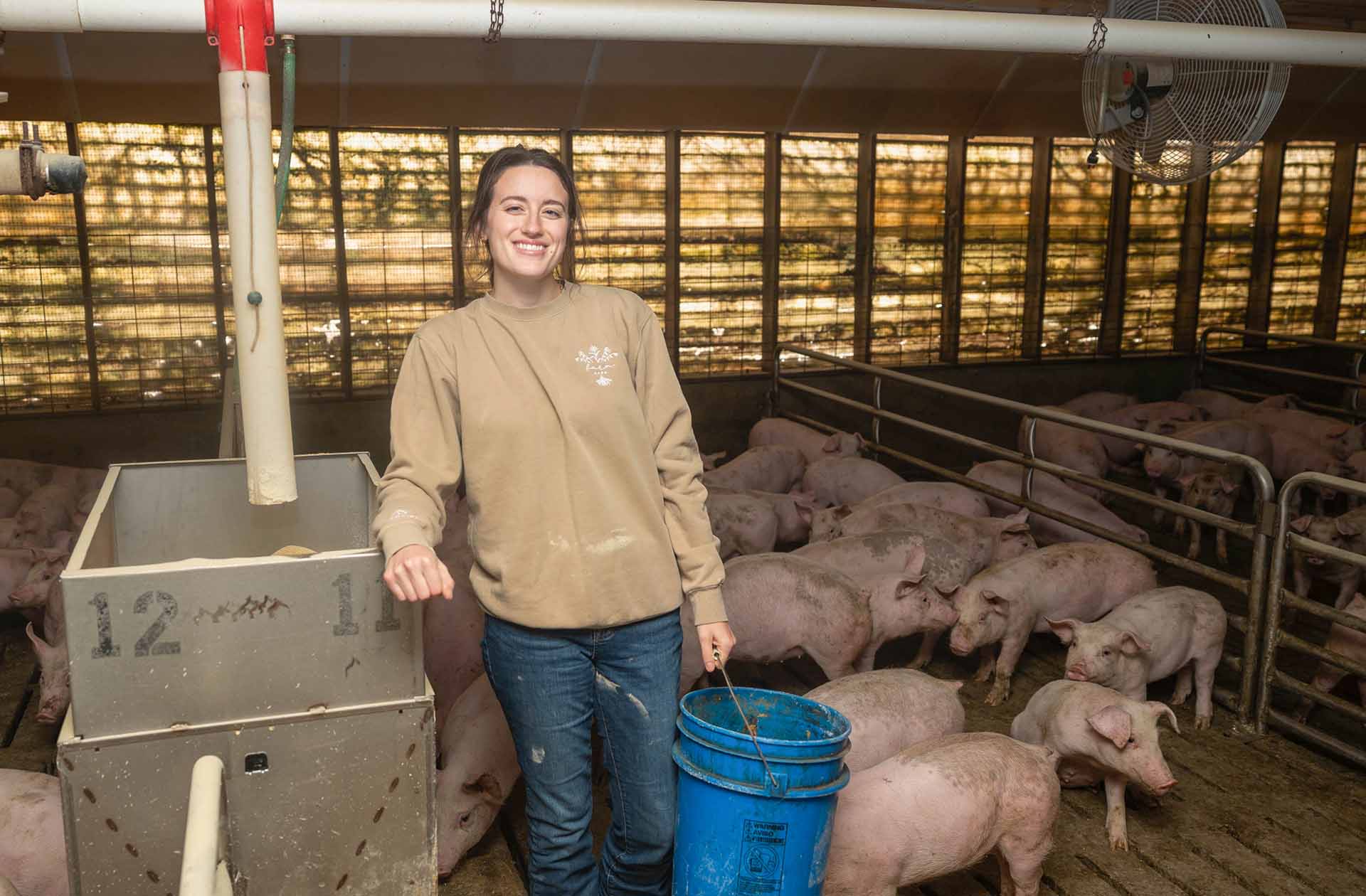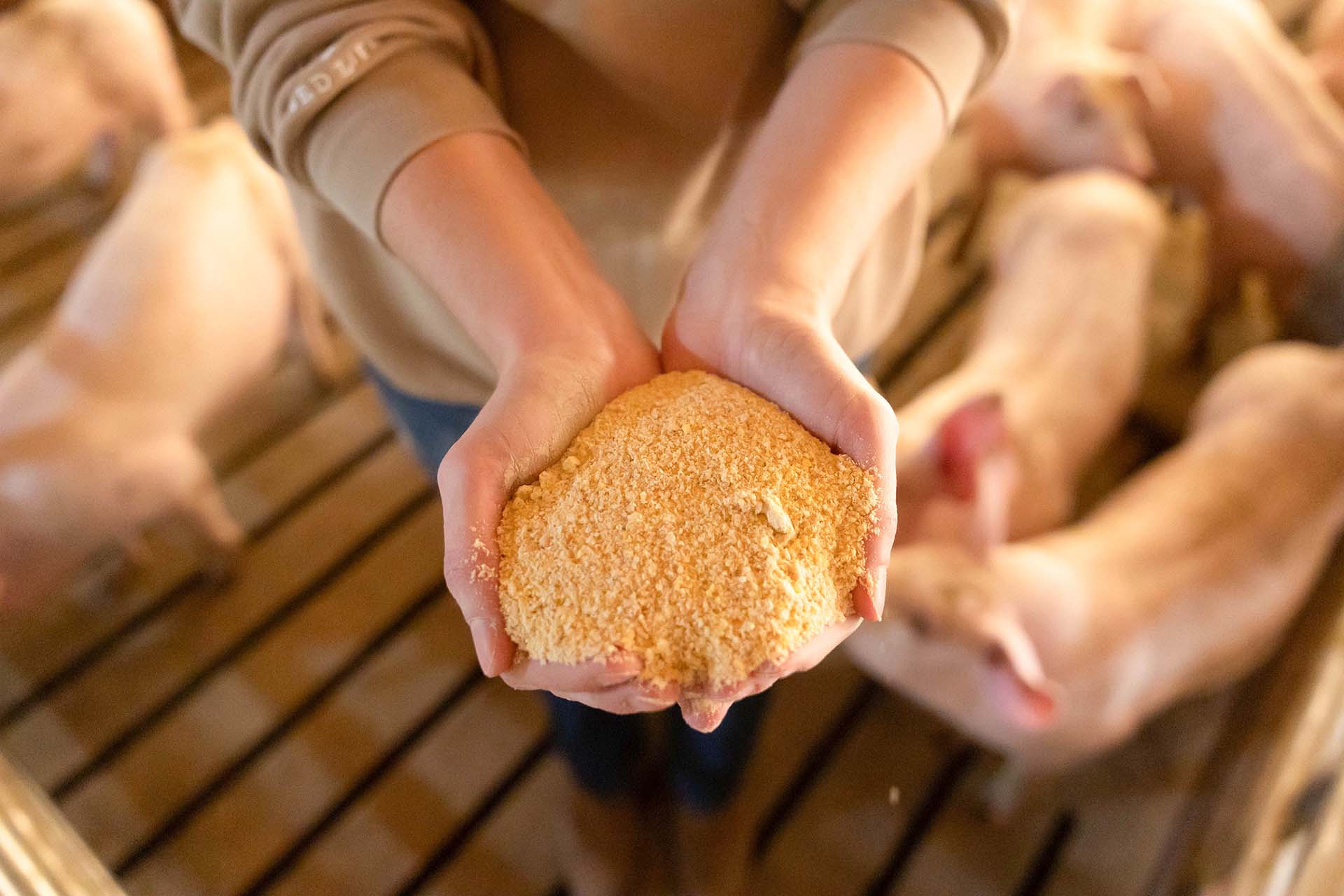
(Photo: Iowa Soybean Association / Joclyn Bushman)
Soy is the complete nutritional package for livestock
February 1, 2025
The value of soy isn’t lost on Amanda Tupper.
An Iowa Soybean Association (ISA) District 3 Director from Chickasaw County, Tupper and her family raise soybeans, corn, cattle and hogs. Some of that soy feeds the hogs she raises; soy is an affordable protein that benefits both animals and consumers who will later enjoy a pork tenderloin, bacon or ham.
“Soy is one of the densest sources of protein; it’s more digestible for our pigs and we get more bang for our buck,” she says.
‘Symbiotic relationship’
Tupper’s pigs enjoy a healthy diet of soybean meal throughout their lifecycle.
When the pigs first enter the Tupper farm’s nursery, about 30% of their diet is soy. As the pigs grow, the percentage of soy in the feed ration decreases. But roughly 10-12% of their diets include soy through to the finishing stage of their lifecycle.
“We use soybean meal because it’s affordable for us and our customers,” she says. “With the health benefits, it’s good for the pigs, but it’s also better for our bottom line.”
The Tuppers sell soybeans to a local crush plant. The soybean meal then ends up at the farm, going back to feed their pigs.
“There’s a symbiotic relationship in that cycle,” she says.
Sourcing a homegrown resource makes a difference in the farm’s budget, Tupper says.
“It’s been a little rough raising pigs the last couple of years, so it makes sense to use as much soy as we can.”
“On the value side of things, soymeal is readily available, it’s cost effective for our operation and it’s produced locally,” she says. “It really does help our bottom line and on the consumer side of things it helps to keep food prices low.”

Fit for multiple species
Tupper is not alone in her support of the use of soy for livestock.
Former ISA Director Scott McGregor from nearby Nashua utilizes soymeal for his cow-calf operation.
“Soybeans are really important and provide important amino acids for our calves,” he says. “The soymeal pellets that we use have been a great benefit to our animals.”
McGregor says it’s important to recognize the value soy has for multiple livestock markets because Iowa’s soybean producers are always looking for new opportunities to share and sell their soybeans.
And Gretta Irwin, the executive director of the Iowa Turkey Federation, can attest to the value of soy for Iowa’s more than 130 turkey farms across the state.
“We’re utilizing local sources of feed, and that’s good for rural Iowa,” she says.
Locally sourced products like soybean meal contribute to the value-added chain within agriculture.
“And Iowa soybean meal adds to the confidence that consumers have about the safe ingredients we’re using in our turkeys’ diets,” Irwin says.
Roughly 12 million turkeys are raised annually in the state.
“On average, one turkey consumes about a bushel of corn and one-third of a bushel of soybeans over its lifespan,” says Irwin, adding soy is clearly an important source of calories and energy.
And it’s not just turkeys, cattle and hogs.
The North Central Poultry Association and the Iowa Egg Council report Iowa’s chicken layers consume 55 million bushels of corn and nearly 505,000 tons of soybean meal yearly. And in Iowa there are nearly 45 million laying hens.
Dr. Stacey Roberts, director of nutrition at Versova, a company that brings together egg producers from Iowa, Ohio, Washington, Oregon, Utah and Colorado, says soybean meal is critical to the overall health of their hens.
“For me as a nutritionist, soymeal is plentiful and readily available,” she says. “We use soymeal primarily for its protein and amino acids. It complements corn in meeting the nutritional needs of our animals and what we need in chicken feed.”
Roberts says soymeal is part of a “nutritionally robust nutrition program for the chickens, ensuring our hens have what they need.”
Rising global demand
U.S. soybeans are generally considered to offer increased benefits, compared to other soybean-producing countries including higher sucrose levels, superior amino acid profile, better digestibility, increased metabolizable energy and lower fiber.
And with demand for soybean oil and bio-based feedstocks for fuel production on the rise, more markets are recognizing the value and versatility of soybean oil. This emerging demand positions soybean oil as an important value driver relative to soybean meal.
Processors are increasing their crushing efforts to produce oil. And as crushing for oil expands, meal production will increase as well, providing an opportunity for U.S. soybean producers to set the standard for growing more plant-based protein sources like soybean meal.
Vital component
Be it chicken, turkeys, cattle or hogs, soybeans are a critical component within the livestock industry.
“Soy is pretty vital to our operation, especially on the livestock side of things,” says Tupper. “It’s affordable, provides high-protein content, is gut-friendly for the hogs. It allows us to continue to raise livestock generation after generation. Soy will always be a part of our feed rations — not only on our farm, but overall, for the industry.”
Back